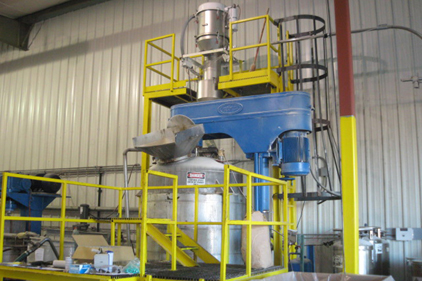TECH FLASH
Calculating the ROI of pneumatic conveyers
Pneumatic conveyers can help operations engineer hazards and ergonomic inefficiencies out of process manufacturing.

According to OSHA, “manual material handling is the principle source of compensable injuries” in the goods producing industry. And when workplace injuries occur, workers aren’t all that is hurt—so are profits. It is estimated $250 billion is lost due to workplace injuries and illnesses every year. Processors know workplace injuries and illnesses are counterproductive to the bottom line, but may be hesitant to adopt new technologies without proof of sufficient return on investment (ROI).

|
| Using pneumatic conveying systems to eliminate ergonomic issues and potential costs associated with injury often results in increases in productivity. Source: Vac-U-Max |
Ideally, hazards would be engineered out of the process, but that isn’t always possible. However, use of a pneumatic conveying system can reduce fall hazards and back injuries as well as control fugitive dust.
Pneumatic conveyers use vacuum technology to gently and quickly convey material from point to point. Suitable for batching, conveying and weighing dry materials from fine powders to plastic pellets and caps, they consist of five pieces of equipment: a pick-up point, convey tubing, a vacuum receiver, a vacuum producer and a control module. Systems also may offer semi-automation or complete automation, but all offer improved safety.
While no single formula exists for determining ROI of engineering a safety hazard out of a process, data easily supports the contribution of pneumatic conveyers to the bottom line through reduced or eliminated hazards and gained productivity. OSHA’s $afety Pays (SP) worksheet is one tool that helps managers quantify the benefit of hazard reduction/elimination. The worksheet estimates that, with a 5 percent profit margin, the indirect costs of back injuries average in excess of $30,000 and require additional sales of $672,122 to recoup losses. These costs should be taken into account when determining ROI.
Ergonomic improvements can enhance production significantly. The American Society of Safety Engineers (ASSE) offers a worksheet for calculating ROI of ergonomic improvements using the following formula: Projected productivity impact percentage = (total time savings)/(total operations time)x100. Annual savings = (productivity impact)x(annual direct cost), and Payback period in years = (cost of improvement)/(annual savings).
In one example, an ergonomics team was able to save .4 seconds per repetition of a particular task by moving an inconveniently located screw bin closer to the worker, resulting in a 32 minute per shift time savings. But the team wanted to save even more time and money, so it investigated installing a self-feeding driver at a cost of $2,500. The self-filling driver would eliminate three tasks and 3.2 seconds per task repetition in a 12-second task cycle.
Using the equations above, we find the projected productivity estimate is 27 percent. ASSE uses a conservative productivity impact of 17 percent (by estimating only 2.1 seconds per task cycle removed), and multiplies that by the current annual direct cost of $36,250 (direct labor cost plus benefits burden) to arrive at an annual savings of $6,162. That savings represents a payback period of only .4 years, or 4.8 months, and a three-year ROI of 639 percent.
Translated to pneumatic conveyers, consider the common scenario of needing to transport material to a raised platform and dump it into a hopper. This process represents not only ergonomic hazards but fall hazards and the possibility of fugitive dust. A proactive executive will seek to eliminate these hazards before an accident occurs, and would benefit from the ability to undertake an ROI analysis like the one above. Even if the time required to complete a task stays the same, the reduction of operator hazard and eliminating the possible need to hire another operator can represent significant ROI.
For more information on pneumatic conveyers, contact Doan Pendleton: info@vac-u-max.com.
Looking for a reprint of this article?
From high-res PDFs to custom plaques, order your copy today!





